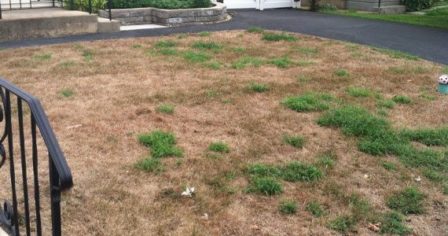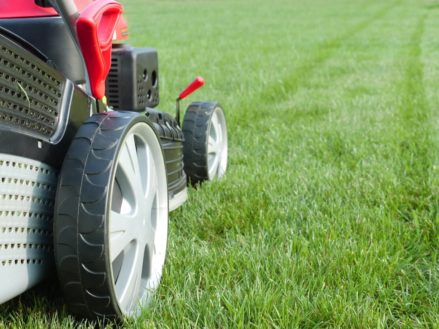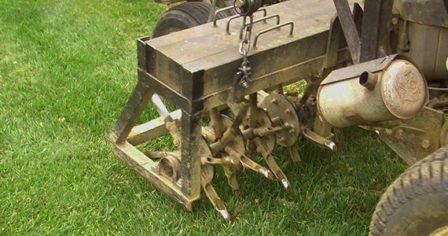You think you have stress? What about your grass? People walk all over it. The sun beats down on it. It’s thirsty, and weeds want to take over. Yes, it’s rough out there in the lawn. We’re here to help your lawn recover from summer stress.
But you can take some easy steps to help your lawn deal with the stresses of summer by implementing these steps! Some may feel this is extra work. But if something is worth having, isn’t it worth putting in the extra work and effort? We protect our family, money, home, and cars, but we neglect a part of our lives that we spend a lot of time on – our lawn! It is not enough just to fertilize and treat weeds, we have to cultivate a healthy lawn to better benefit our lives. We have to think of our lawn as a living thing, which is precisely what it is.
Summer Stress Factors for Your Lawn
Heat, dry weather, and foot traffic are major stresses for cool season grasses. Others include weeds and turf-damaging insects, but these issues can become worse when your lawn is already suffering. Think of your lawn as a person…. if you were dealing with all of these issues you would be stressed too!
Keep Your Mower Blade Sharp and High
Most cool-season grass types prefer to be mowed high, so set your blade at one of the highest settings on your mower. Taller, thicker grass provides shade for soil, which in turn provides relief for root system from heat. Also, grass stores most of its moisture in the leaf, so leaving the blades longer means turf is more resistant to drought stress.
 Mowing too low has other negative effects. An increase in the sunlight reaching weed seeds, allowing them to germinate is one example. Injury to the crown, where new growth generates and nutrients are stored is another side-effect. Lastly, reduction of the surface area of the blade, making the blade surface insufficient to produce food through photosynthesis can damage the turf.
Mowing too low has other negative effects. An increase in the sunlight reaching weed seeds, allowing them to germinate is one example. Injury to the crown, where new growth generates and nutrients are stored is another side-effect. Lastly, reduction of the surface area of the blade, making the blade surface insufficient to produce food through photosynthesis can damage the turf.
Sharp mower blades are critical, too. Dull mower blades shred grass rather than cutting it. The result is that the turf loses more moisture than it would with a clean cut. Also, the shredded tips turn brown, making the lawn look unpleasant.
Besides that, this shredding of grass blades creates an opportunity for disease to get into the turf. When the turf is cut by a dull blade it creates an open wound which makes it easier for the disease to infect the turf. On the other hand, a clean cut will keep turf intact and protect itself from disease.
These are not all the risks you face when mowing incorrectly, but it is important to understand the need to put in a little extra work to get great results.
If You Water, Do It in the Morning
Water is an essential part of a happy, healthy lawn, which is something we all want. It’s important, though, to make sure you water it properly. Watering in the morning, between 6 a.m. and 10 a.m., is the most efficient time to water your lawn. Less water is lost to evaporation and your lawn has time to dry off before nightfall.
 If you run a sprinkler at night, for example, it sets up the perfect conditions for disease to take hold. Why you may ask? Water can cling to the blades of grass overnight, and standing water promotes fungus. A wet lawn at night is the perfect condition for fungus to grow.
If you run a sprinkler at night, for example, it sets up the perfect conditions for disease to take hold. Why you may ask? Water can cling to the blades of grass overnight, and standing water promotes fungus. A wet lawn at night is the perfect condition for fungus to grow.
If you water too lightly, the grass roots will not grow deeply enough, setting your lawn up for trouble when hot weather hits. So, it is ideal to water your lawn about one inch of water per week. To determine how long you need to water you can use an empty tuna can. Place the can halfway between the sprinkler and the extent of the water’s reach. Once the can is full it is safe to move on to the next section of lawn and continue the process. This will make your life easier and provide the lawn with the water it needs to combat summer stress.
Try Not to Walk on Your Lawn
When you walk on a well-watered lawn, the grass blades spring back and stand upright. On a dry lawn, the grass stays beaten down, and the grass itself can be damaged.
To educate you, an early sign of drought and summer stress would be footprints remaining on grass after it’s been walked on. This is especially obvious in the summer time, when drought stress is at its peak in our area.
Also, heavy foot traffic on wet soil can lead to soil compaction, which keeps air from getting to grass roots. And being in Central Pennsylvania, we have a clay-based soil which is already very compacted.
This is another reason aeration is so important and is our next trick on recovering from summer stress.
 Aeration and Overseed in the Fall
Aeration and Overseed in the Fall
Per Penn State “aeration provides an excellent, and probably the only, means of correcting or alleviating soil compaction. Compaction can greatly impede water infiltration, and nutrient penetration.”
Aerators remove plugs of soil from the turf area to loosen compaction. Aeration is integral to maximizing your chances to maintain a healthy lawn throughout the season, but in particular the summer time due to our clay-based soil.
Clay soils get compacted and hard, which make it difficult for water to pass evenly and for your turf’s root system to expand properly. If your lawn is prone to heat stress, you might want to overseed it in the fall with a grass that’s been bred to handle heat and drought. Immediately after you’ve aerated is a great time to do this, to ensure seed-to-soil contact.
Our lawns deal with a lot over the seasons which effects the thickness. Seeding is going to help your investment by thickening the lawn up which will help with its ability to handle these tough conditions. It will help rejuvenate the turf and fill in thin or bare spots, this is why aeration and seeding are integral to maintaining a healthy lawn.
If you have questions about helping your lawn recover, please Contact Us, and we’ll be happy to give you a Free Consultation!

